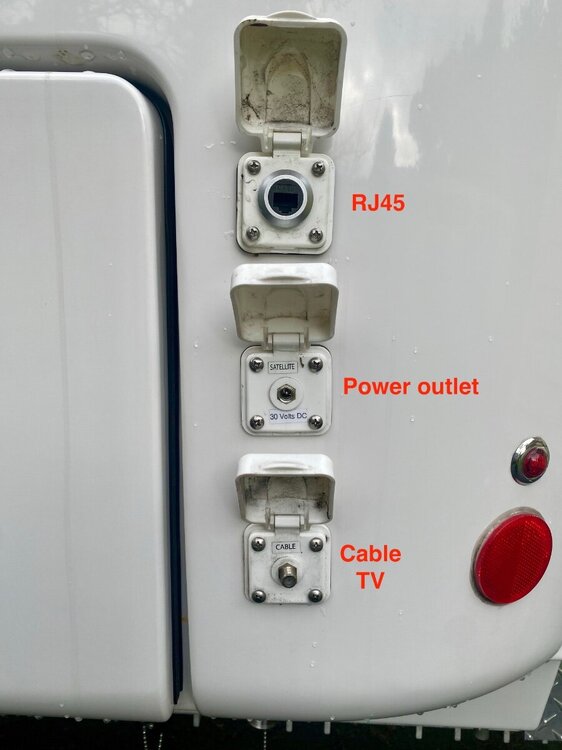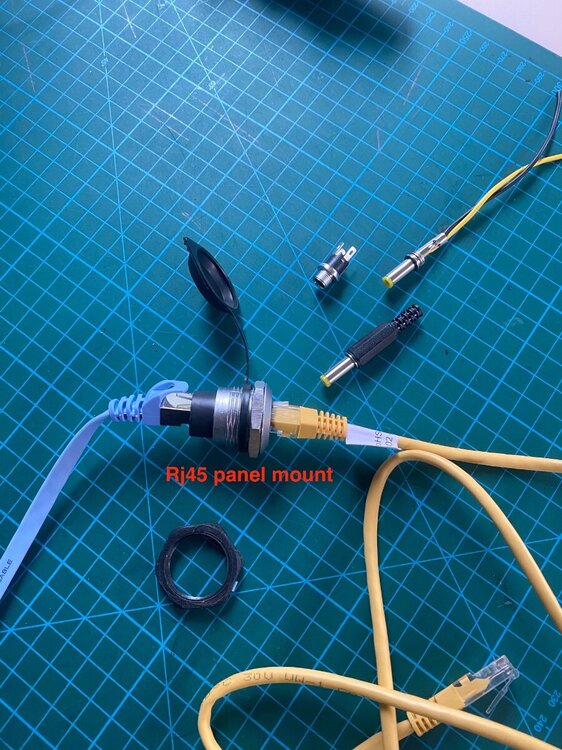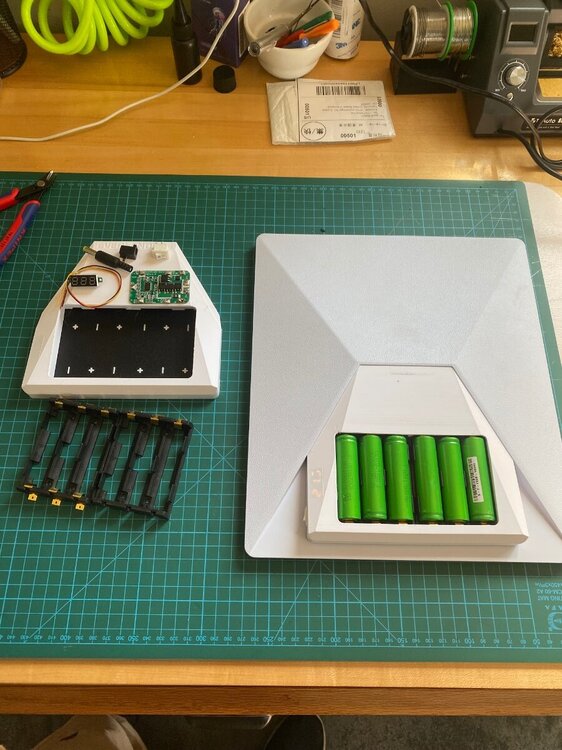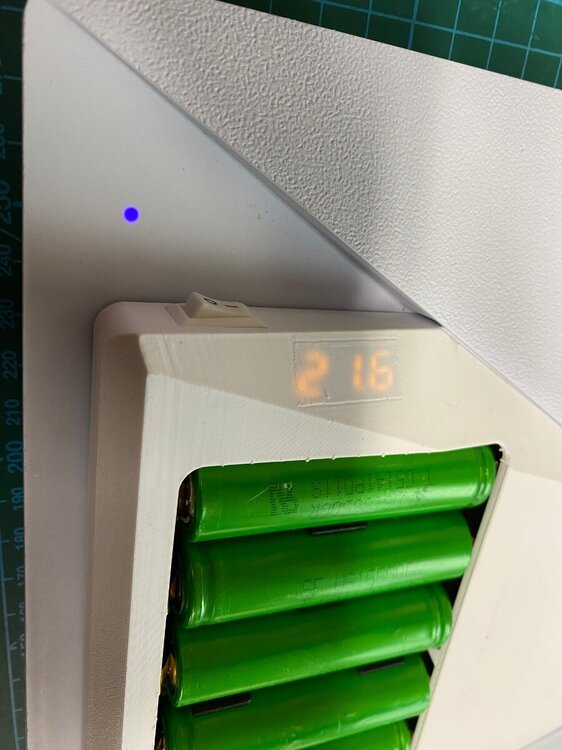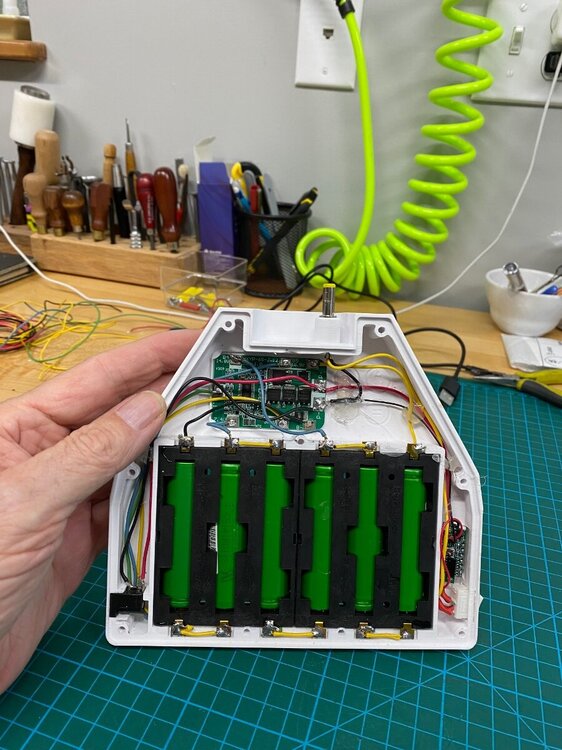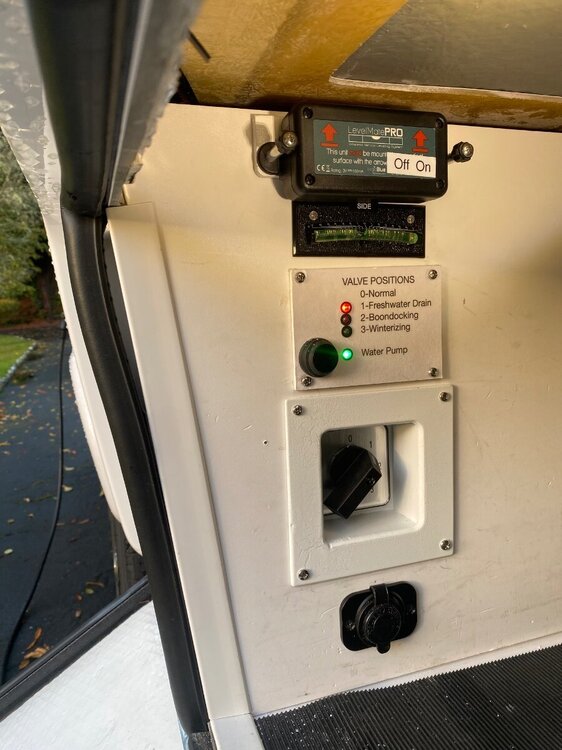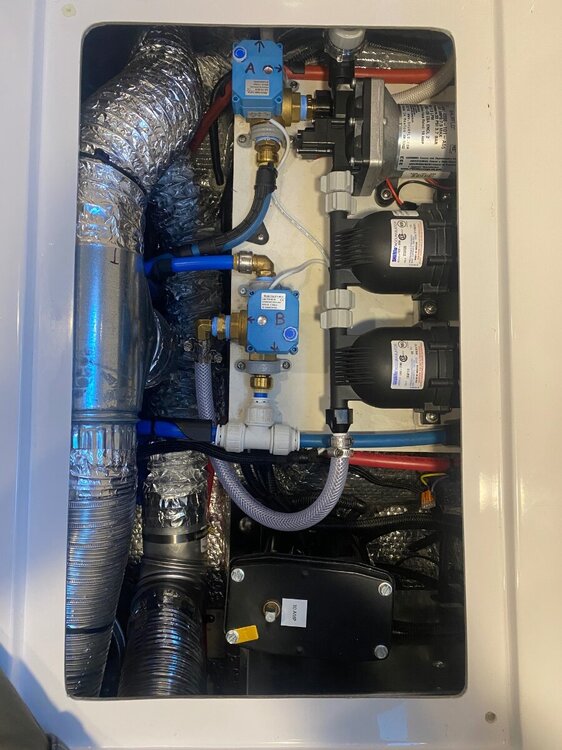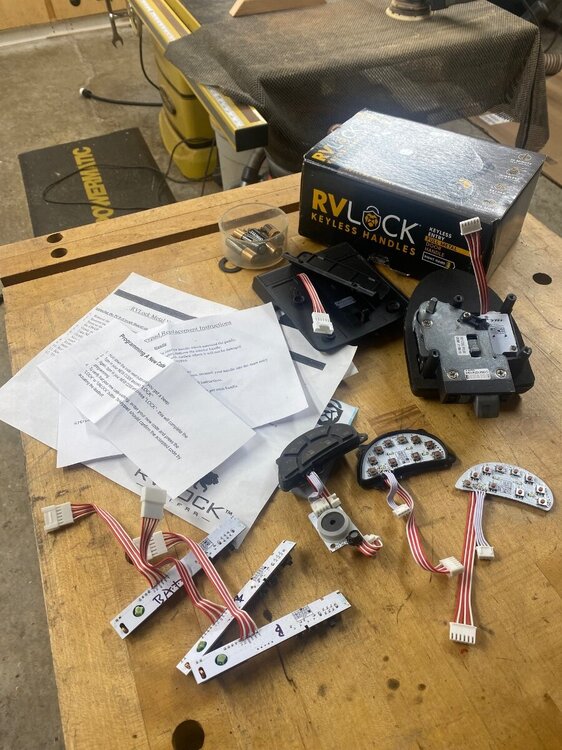
Snackchaser
Members-
Posts
196 -
Joined
-
Last visited
-
Days Won
11
Everything posted by Snackchaser
-
Yea after miles of dirt road the dust gets everywhere. We missed cleaning under the caps but I'm not concerned about it. To get the ethernet cable from the attic to the outdoor garage, you will need to remove the attic's street side wall panel, it's held in by two hex head screws. Also remove two screws to partially pull back the garage side panel. From both locations, you will see the clear poly drain tube for the air conditioner. The gap is wider here, and I was able to snake a fish rod along the side of the tube straight down to the garage without restriction or obstruction from the insulation. A cheap Amazon sectional fish-rod works well here. Always pull an extra string with the cable because it gets harder to get the rod through with each wire added, and you may want to add wires later for my "Turning On The Rear Camera Automatically" modification😁 https://a.co/d/fl9XvxS
-
Yea this stuff could drive anyone nuts! Forgive me that Iv’e showed this before, but it still might help you save $$. I looked at the SmartPort way back when, and was appalled at the price. Also it would stick out like a sore thumb on the Oliver. You can buy another matching Furrion outlet for $9 and a RJ45 panel mount (two) for $16. Just have to drill the Furrion hole bigger and the RJ45 panel mount will fit right in. It’s a double female, so any Cat 6 RJ45 patch cord will work on the inside, just fish it up the wall into the attic. There is a clear path next to the AC drain tube. Gosh, that photo looks like it's mounted crooked🫢 A female 5.5 mm barrel connector will screw into the Furrion without any drilling if you want to go that route. You can even make your own Starlink Mini power cord from cable, at least #16, and run the Mini without boosting the voltage. https://a.co/d/6ZfCA1Q https://a.co/d/5YNGSrP https://a.co/d/9p1RQpP https://a.co/d/hszApCd
-
There are battery isolators for charging, but I've never seen one that would work for your purpose of using both sources at the same time to power your Mini. You would be essentially wiring the batteries in parallel, and it's also a no-no to mix lithium and lead acid. I'm sure you could rig up a diode affair, but that's not very realistic. I'd keep them separate with a "On - Off - On" toggle switch to feed the Mini from one source or the other . . . or off! The common terminal goes to the Mini, the others to the starter battery and tow harness trailer battery respectively. Ground to the chassis. You can get toggle switches up to 30 amps. A relay will work too, but overkill in this case. Just fuse it properly. 🤙
-
My typical problem with the Mini is "partial" obstructed view, where the connection continuity is impacted when the satellites pass over the blind spots. It depends how big the obstruction is, whether it can be buffered-out without disruption or too much speed loss. I have a Dishy pole mount on the front and rear of the trailer for that reason, and sometimes only that much movement can make a big difference in an obstructed area (See my "Tacky Starlink Dishy Mast" post). Often the obstruction is on the low horizon and a long mast is the ticket. That's another advantage with the lightweight Mini because my heavy Gen-3 Dishy is too wobbly on a long pole. The Starlink App has an interesting feature that maps the sky and shows obstructions. I think it works even without having a Starlink connection if you want to play around with it. It might help you answer the question how well the Mini would work laying flat. Correct, I think mobil cords are around 15-20 feet long compared to the standard 50" cord, so there is no need to boost the voltage. Cheers, Geoff
-
JD, I devised my Victron Starlink Mini power supply because there were no other options available at that time. Now that there are other options available, I’d still prefer the Victron for my setup with the standard 50’ Mini cord. It’s a quality power supply, and I haven’t felt the need for a different router yet. The PoE injector has benefits too. It’s a good option if you want have the Mini more than 50’ away and/or use a separate router for a stronger WiFi signal. The Mini’s built-in router’s WiFi signal can weaken the further away it gets. This hasn't been a problem for me so far, the problem is always obstructed view on the upper horizon from trees and hills. In your setup, with the Pepwave router and Mini mounted permanently on your truck, then you don’t need the Victron or PoE injector. You can simply power the Mini with a shorter 12 volt mobil cord (Amazon). The Mini's connection to the Pepwave can either be a short Rj45 cable or the Pepwave WiFi interface. If you ever want the flexibility to move the Mini away from the truck for clear sky view, then I’d consider either the Victron or PoE injector. It really depends on how you want to connect to the Pepwave. Remember, if your in that situation where you need to move the Mini away from the truck, then you don’t have to connect it to the Pepwave every time. . . or it will still connect through WiFi. . . or carry a longer Ethernet cord and run it parallel with the Mini power cord. You have options. Cheers! Geoff
-
Since you asked; I needed to have a ground pass-through jumper for the "optional" automatic switching using a digital "ground open" trigger😁 Otherwise the jumper isn't needed. And you're right, the jumper un-isolates the Victron but it's a non-issue for this application. Cheers, Geoff
-
JD, unfortunately it’s true that the DC to DC charger does not pass current in the opposite direction to back-feed the truck, otherwise the trailer battery would try to equalize with the truck battery and it could act like a charger in reverse. This is also why the DC to DC charger uses an engine-on sensor to turn it on, otherwise the truck battery would try to equalize with the trailer battery when the engine is off. If you want to use your DC to DC charger cables to run your Mini/Pepwave from the trailer battery, then you would need a relay to go-around the charger on the trailer side, and another (50 amp relay) to isolate the battery on the truck side. Then you would need switches for both with an interlock for safety. It’s rather complicated and expensive, not to mention relay parasite current. A better idea is to use the +12vDC wire from the 7-pin tow harness. It should be spared already on the trailer side, and you would have to isolate it on the truck side to use it as a trailer power feed for the Mini/Pepwave. I used that same wire to automatically turn on the rear camera. Otherwise, I’d recommend adding a separate #12 or 14 circuit in parallel with the DC to DC charger cables. Hope that helps, Geoff
-
I was conservatively using the 300 horsepower rating of our Tesla verses the Honda generator at 2.5 hp. It's actually way less than 1% because the Cyber truck is rated 600 to 800 hp. They say that regenerative braking re-captures about 20% charge, and that's already factored into the range estimates. Our Tesla has never registered an increase of charge even on the longest downhill grades. It sure registers discharge going up them through. 🫢 I see this technology working well for long haulers where they can stop for hours at charging stations. But I think there is still a ways to go before it's practical for campers.
-
The milage increase would be insignificant. The Honda is less than 1% of the horsepower of a Tesla and Energy conservation law states “energy cannot be created or destroyed, but can only be transformed from one form to another.” As Tesla owners, we love the performance and safety aspects of it, and it's defiantly energy efficient. However, I’d never consider one for travel trailer tow vehicle because of the range and charging challenges. I’ll stick with the 2500 RAM.
-
Thanks for your kind words @GaRambler, I hope to get to a rally and meet other Oli owners too!! You folks with the Starlink Mini may also be interested in this compact, self-contained Starlink power supply. It gives the Mini extra portability so you can take it to the campsite of an internet-needy friend, or hiking, or a remote picnic. It uses six common 18650 rechargeable batteries that will power the Mini for several hours. This DIY “StarSled Go” was cleverly designed by @Everlanders using a 3D-printed case and electronic components from AliExpress. It has a power switch, voltage meter, and built-in BMS/equalizing charger. The case can be printed for a couple of dollars’ worth of filament, and parts are so ridiculously cheap that I built extras for fun and gifts. Message me if you’re interested in one. Cheers, Geoff
-
SeeLevel sensors integrated with Victron system
Snackchaser replied to rideadeuce's topic in Ollie Modifications
That would be a "Single Pole Double Throw" (SPDT) switch. I buy my switches from DigiKey company, PN CH876-ND. If you message me privately, I can send you an extra one I have. -
Yea that looks like a quality product. Thanks for sharing! With the voltage boosted to 48 volts, you could run the dishy father away than the standard power cord will allow, and it's easy to make your own ethernet cables with a few cheap amazon tools, bulk wire and connectors. I like the DC modem too! We used to run the Starlink gen 3 modem on the inverter and had to shut it off to save the battery. Now it just stays on all the time without a worry. Cheers, Geoff
-
Hey JT, Also take a look at my other post for getting your ethernet cable into the Oliver in a neat and professional manner: "Don’t cut your Starlink Cable! There’s a better way to install Starlink…" For the Mini, you will still have to run both the power cable and ethernet cable to do what it sounds like you'r describing. The second router is a great idea because, as you know, the WiFi/speed decreases when the Mini is placed further away from the trailer. We travel in the Pacific Northwest with lots of trees so we often have to move the dishy farther away to find a clear sky. Flexibly in that regard is a must for us too! Cheers, Geoff
-
Oh okay. Thought you were messing with me because I have posted several automation projects. Take a look at my post “Electric valve control... with a twist” where I installed motorized valves all connected to a single selector switch. It takes the error out of valve line-ups and it was a fun project. We don’t winterize, but we often use the boondocking position, and we usually drain and re-fill freshwater after every trip. I just hated lifting our oversized mattress too! I don’t think anyone has copied that modification yet because there were no comments about one of the 3-way valves being backwards. I really should update that photo with the corrected valve orientation 🤔
-
Oh Yea, you're jerking my chain now! I'll take the bait though😂 I used a 4 -position rotary switch with LED position indicators and automatic return to normal... proud to say.
-
Although I’m not sure how much difference it makes, maximum flow is important to me as well. With all the plumbing modifications I’ve made, I did’t want to introduce too many more restrictions in the system. I actually used 3/4” motorized ball valves, and SharkBite fittings wherever practical. I also heated and bent the PEX pipe instead of 90 deg. fittings whenever possible, and used 90 deg. plastic sweep clips to maintain the bend. Every little bit helps IMO!
-
We were down in Cabo San Lucas last month and saw an Oliver parked on the beach! Unfortunately we were headed to the airport and couldn’t stop, but Iv'e been wondering who that was, and how the trip down Baja went? I’d love to make that trip in the Oliver too! But not without the backup and support of a large group.
-
Another "pro" for the SharkBite fittings is that they have a larger internal diameter. They go over the PEX pipe, where-as the crimp-on fittings insert into the pipe creating a slight restriction. Both types of fitting work fine, but I'd recommend getting a crimp ring cutting tool. They are inexpensive, and they make it easy to salvage crimped on fittings.
-
This was a reminder that some state and federal campgrounds have very small sites, particularly in older parks. Unfortunately it’s difficult to know that ahead of time. For instance, we’ve spent many weekends at Jedidiah Smith with our Elite II, and there are plenty of usable sites. However, you wouldn’t know that from the website, and the Rangers might try to discourage you because some people will block the road. We always drive the loop to see for ourselves, and we keep maps of every campground we visit with the best sites noted for future stays. Sometimes Google Maps (satellite view) is helpful to check-out the sites beforehand, as long as it's not forested.
-
Two of my least favorite things about the Oliver are the awning that can’t be used in the rain and the floppy/noisy bathroom door. I’ve long wanted to replace the door with a wooden one, but being a custom furniture maker, wifey has forbidden it because that's what I always do. No more wood! She just wants to keep with the shiny modern look for a change. So, when I told her about Oliver’s new fiberglass bathroom door, she loved the idea and surprisingly suggested that I make one just like it. Oh no! This could be problematic. I have no idea how the new door was designed, except that it appears to be made of fiberglass. Since I won’t likely see one in person anytime soon, I’d be grateful if anyone could share details or close-up pictures of the door. I’m curious about the jam, hinges, hasp, and finishes on both the inside and outside. I’m also wondering how the mirror is attached, if it has a bezel or frame, and if the door is two-layered or similar to the closet door with the gelcoat on the inside. If it seems doable without major wall or door jam modifications, I might build a reusable mold and try giving it a go. Any insights or opinions on this are welcomed. Cheers! Geoff
-
Accessories unplug themselves…
Snackchaser replied to Galileo's topic in Mechanical & Technical Tips
Galileo, Plugs should have a fairly tight fit in the receptacle and they will not easily fall out. However, we have all run across worn out, or poor quality, receptacles that the plug will not stay in. When a plug is loose in the receptacle, it means that the electrical connection is also loose! It’s one of the most common causes of fire. Loose connections have a high resistance that create heat, and/or arcing. It’s best to replace the receptacle. Otherwise, bend the plug prongs outward just a bit to improve the connection and the holding friction. Hardwiring is okay, but it shouldn't be needed. Cheers! Geoff -
JD, I was reading your post, but I struggle with acronyms. I believe you’re asking why a 120-volt current through a #14 gauge wire can charge at 50 amps, while a 12-volt current through a much larger #4 gauge wire can’t. The answer lies in Ohm’s Law (E=IR), which states that voltage (E), current (I), and resistance (R) are directly proportional. Therefore, as voltage increases, current decreases. A good analogy is the 700 kilovolt transmission lines that can power a city through a wire the size of your thumb. If you reduce the voltage to 120 volts, then you would need a wire thicker than a redwood tree to carry all the amps. Regarding the Orion, it’s a type of Buck Booster, which means it can increase the voltage of a low-voltage input to a higher voltage output. However, an undersized feed cable from the tow vehicle still experiences voltage drop due to cable resistance (E=IR again), which will affect the charger’s performance. Look at it like a toaster, the heating element is basically an undersized conductor that is heating up due to its high resistance. It effectively limits current exactly like a resistor in an electronic circuit does. I hope that answers your question, and I apologize if I’ve misread it. Cheers! Geoff
-
I totally agree with all the recommendations above, except I'd also skip the WA coast past the Oregon border! If you want to continue North toward Canada, and see the area around Port Townsend, then that's worth it and little more complicated for a short discussion. I was glad to see that Lassen Volcanic Park is already on your list, it’s one of our favorite National Parks with lots to do and see in the area. Lassen’s Manzanita Lake campground, surrounded by snow capped mountains, is spectacular. If your a fisherman, there is premier fly fishing in the lake, and nearby Hat Creek. And since you will be that far south, then come 4 hours West to Eureka! South of Eureka is the famous Avenue of the Giants (Redwoods) and many great campgrounds. North of Eureka, Hwy 101 goes all the way up the CA and OR coast with lots more redwoods mostly on the CA side. As mentioned, most of the state parks are typically booked six months in advance during the summer, and it’s best to reserve if you can. But we travel the coast every summer without reservations, which is doable if you're willing to hit a few different places and shop around while exploring. Many of the local camps are still first come first serve, and there are always last minute cancelations and private campgrounds. Some parks have un-reserved ADA sites, and you can usually stay there after 5:00. We like the flexibility of not being on a reservation schedule because sometimes the rain totally sucks, and other times it's gorgeous. Patrick's Point, recently renamed Sue-Meg, is another of our favorite spots just minutes north of Eureka. There is whale and seal watching from the cliffs, a Sumac Indian village, Agate Beach, scenic Trinidad Harbor, nearby Elk herds, and great walking trails. Jedediah Smith Redwoods State Park is another great spot just east of Crescent City. It's a lessor known park on the beautiful and sparkling clear Smith River. There is a recently discovered ancient redwood groove within a short walk that is protected with elevated walkways. Yes, it’s true! We also recommend taking a scenic jet boat tour up either the Klamath or Rouge rivers. Oh, and stop at the giant Paul Bunyan and Oxen attraction near Orrick, CA. It looks like a kids place, but it’s well worth stopping for the museum and the gondola ride above the old growth redwood canopy. If you get in a pinch near Eureka, give us a shout. You can alway hook-up in our yard under the redwoods, next to a massive 1500 year old stump. There might be some bears around, and there might definitely be snacks! Cheers! Geoff
-
Yes, definitely sign up for the T-Mobile Beta program! It’s a rapidly growing technology that is the future of cellular service. T-Mobile is actively seeking new subscribers by offering the free Beta plan to get a jump on other major carriers, such as AT&T, who have similar satellite-based plans in the works. So the more people that sign up, the quicker the industry will respond. Currently, the T-Mobil/Starlink Beta plan only offers basic SMS text messaging with very limited bandwidth. . . which would be good for emergencies. No calling or data. This will likely increase as more Satellites are launched, but who knows how long that will be. So still consider a Dishy, I think they are on sale right now. Cheers! Geoff
-
There are lots of Olivers with the keyless RVLock so I thought it's worth sharing our good experience with this great company. We decided to install an Amazon-purchased RVLock keyless door handle ourselves instead of buying it as an Oliver option. The installation was quick and easy, and it comes with a generous lifetime warranty. The locks are made in Utah by a small company, and they look and feel like a quality product. Unfortunately, however, there have been issues with the electronics because it has failed three times already! It first failed after about six months, and I called the company for the warranty claim. They wanted proof of purchase, then sent a replacement KPD keyboard and PCD circuit board with installation instructions. We were able to look up the receipt on Amazon and received the parts in a few days. It failed again about a year later, and RVLock still had me in their system. They immediately sent more replacement circuit boards with a new rubber keypad cover. This time, I applied sealer around the lock even though there were no signs of water intrusion. Unfortunately, it failed for the third time a few weeks ago. The RVLock company’s customer service was apologetic and said that they’ve done some design changes to address the problems. This time, they sent upgraded circuit boards, a new speaker circuit board, a foam gasket, and instructions. There was a shipping charge of $3. I hope that this is the final fix because we genuinely love the lock and we wish success for companies that stand behind their products. Cheers! Geoff



